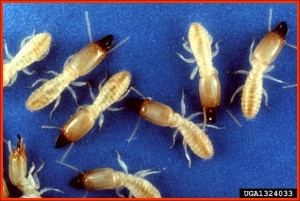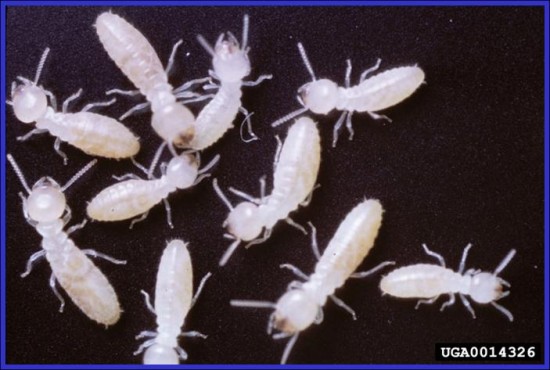
Eastern Subterranean termites
Eastern Subterranean termites (Reticulitermes flavipes)
Subterranean termites are the most serious wood destroying pest in Michigan and are much more common than most people realize. Chemical treatment and commercial bait systems (Senitron) employed to protect structures against termites may cost over $2,000 for an average size home. New products like Termidor® offer improved termite protection by providing non-repellent barriers that can eliminate termite colonies. Do-it-yourself bait systems may reduce termite numbers but probably will not rid a structure of termites. Termites prefer wood of high moisture content. Correspondingly, severe termite damage is often concentrated in areas where excessive moisture conditions persist. In many cases, these excessive moisture conditions are the direct result of an imperfect building design and/or construction practices used to build the home. Some of the common building imperfections which attract termites include improper ventilation of enclosed spaces, boards in direct contact with soil, improper flashing between homes and attached porches and decks, and inadequate slope of the grade next to the building. The best defense against termites is a well maintained, dry structure. The presence of winged termites in home strongly indicates an active termite infestation.
Subterranean termites build their nests in moist soil. They will eat any source of cellulose they find and are able to chew up. The presence of winged termites indicates a mature colony that has been present in or around the structure for a minimum of 5 to 7 years. Even though they may eat the wood in our homes, they must always return to their nest in the soil to replenish body moisture lost during feeding above ground. Termites eat boards from the inside out and leave only a thin layer of wood on the surface. Their damage may remain undetected for years. They can enter wood that is not in direct contact with the soil by building shelter tubes over or through concrete foundations.
On-slab construction is the most susceptible type of construction because termites can enter through any crack in the slab that’s wider than a one thirty-seconds of an inch. Also, structures built on slabs are nearly impossible to inspect for termites because so little of the frame of the structure is exposed near grade level where termite activity usually begins. In structures with basements, rim joists and sill plates are commonly the first areas where termite mud and shelter tubes can be detected. Probing these boards with an ice pick, knife, or screwdriver should be done during any termite inspection. Termites are often first noticed during remodeling projects.
Although termites can cause extensive and serious damage to wooden structures, this damage occurs very slowly. A mature colony of 60,000 termites will eat the equivalent of a 2 foot length of 2X4 lumber in a year’s time. Unfortunately, the equipment and materials needed to effectively treat termite infestations are only available to pest control companies. If you need treatment for termites be sure to select a reliable firm with a good tract record and guarantee. Since the damage occurs slowly, you have time to select the best company. Shop around for the most complete treatment and best guarantee for your money, don’t be rushed by aggressive salespersons.






 Print
Print Email
Email




